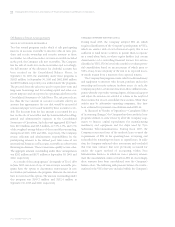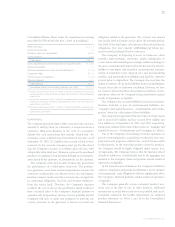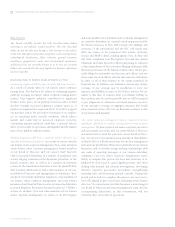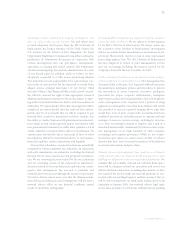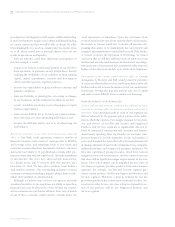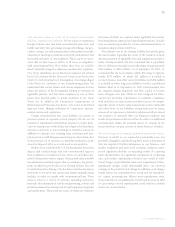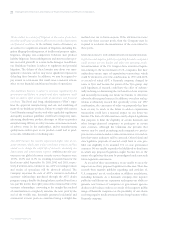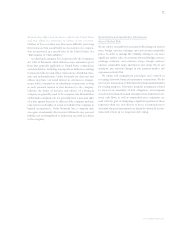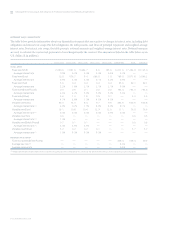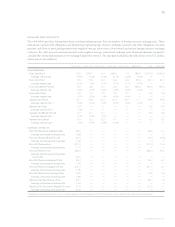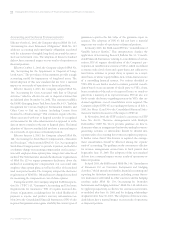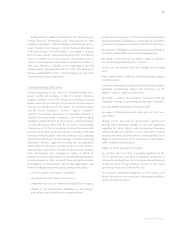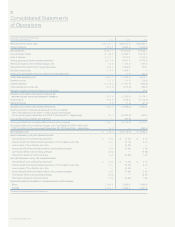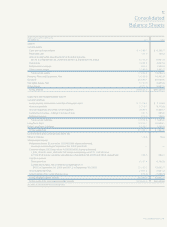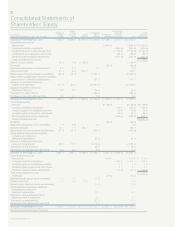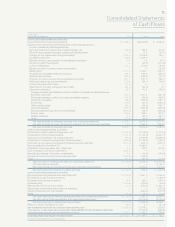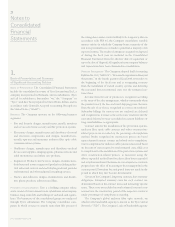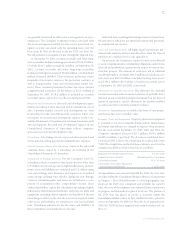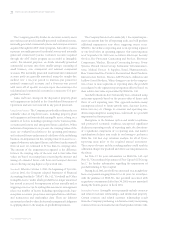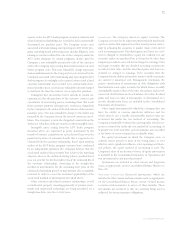ADT 2003 Annual Report Download - page 66
Download and view the complete annual report
Please find page 66 of the 2003 ADT annual report below. You can navigate through the pages in the report by either clicking on the pages listed below, or by using the keyword search tool below to find specific information within the annual report.
64
Accounting and Technical Pronouncements
Effective October 1, 2002, the Company adopted SFAS No. 143,
“Accounting for Asset Retirement Obligations.” SFAS No. 143
addresses accounting and reporting for obligations associated
with the retirement of tangible long-lived assets and the associ-
ated asset retirement costs. The adoption of this new standard
did not have a material impact on our results of operations or
financial position.
Effective October 1, 2002, the Company adopted SFAS No.
144, “Accounting for the Impairment or Disposal of Long-
Lived Assets.” The provisions of this statement provide a single
accounting model for impairment of long-lived assets. The
initial adoption of this new standard did not have a material
impact on our results of operations or financial position.
Effective January 1, 2003, the Company adopted SFAS No.
146, “Accounting for Costs Associated with Exit or Disposal
Activities,” which is effective for exit or disposal activities that
are initiated after December 31, 2002. This statement nullifies
the FASB’s Emerging Issues Task Force Issue No. 94-3, “Liability
Recognition for Certain Employee Termination Benefits and
Other Costs to Exit an Activity (including Certain Costs
Incurred in a Restructuring).” This statement requires that lia-
bilities associated with exit or disposal activities be recognized
and measured at fair value when incurred as opposed to at the
date an entity commits to the exit or disposal plans. The initial
adoption of this new standard did not have a material impact
on our results of operations or financial position.
Effective January 1, 2003, the Company adopted SFAS No.
148, “Accounting for Stock-Based Compensation
—
Transition
and Disclosure,” which amends SFAS No. 123, “Accounting for
Stock-Based Compensation” to provide transition methods for
a voluntary change to measuring compensation cost in connec-
tion with employee share option plans using a fair value based
method. The Statement also amends the disclosure requirements
of SFAS No. 123 to require prominent disclosures about the
method of accounting for compensation cost associated with
employee share option plans, as well as the effect of the method
used on reported results. The Company adopted the disclosure
requirements of SFAS No. 148 and has not changed its method
for measuring the compensation cost of share options.
During fiscal 2003, the Company adopted FASB Interpreta-
tion No. (“FIN”) 45, “Guarantor’s Accounting and Disclosure
Requirements for Guarantees.” FIN 45 requires increased dis-
closure of guarantees, including those for which likelihood of
payment is remote, and product warranty information (see
Note 20 to the Consolidated Financial Statements). FIN 45 also
requires that guarantors recognize a liability for certain types of
guarantees equal to the fair value of the guarantee upon its
issuance. The adoption of FIN 45 did not have a material
impact on our results of operations or financial position.
In January 2003, the FASB issued FIN 46, “Consolidation of
Variable Interest Entities.” This interpretation clarifies the
application of Accounting Research Bulletin No. 51, “Consoli-
dated Financial Statements,” relating to consolidation of certain
entities. FIN 46 requires identification of the Company’s par-
ticipation in variable interest entities (VIE’s), which are defined
as entities with a level of invested equity that is not sufficient to
fund future activities to permit them to operate on a stand-
alone basis, or whose equity holders lack certain characteristics
of a controlling financial interest. For entities identified as
VIE’s, FIN 46 sets forth a model to evaluate potential consoli-
dation based on an assessment of which party to VIE’s, if any,
bears a majority of the risk to its expected losses, or stands to
gain from a majority of its expected returns. FIN 46 also sets
forth certain disclosures regarding interests in VIE’s that are
deemed significant, even if consolidation is not required. The
Company adopted FIN 46’s accounting provisions as of July 1,
2003. See Notes 12 and 30 to the Consolidated Financial State-
ments for further discussion of the impact of FIN 46.
In November 2002, the EITF reached a consensus on EITF
Issue No. 00-21, “Revenue Arrangements with Multiple
Deliverables.” EITF No. 00-21 provides guidance on how to
determine when an arrangement that involves multiple revenue-
generating activities or deliverables should be divided into
separate units of accounting for revenue recognition purposes.
It further states, that if this division is required, the arrange-
ment consideration should be allocated among the separate
units of accounting. The guidance in the consensus is effective
for revenue arrangements entered into in fiscal periods that
began after June 15, 2003. The adoption of this new standard
did not have a material impact on our results of operations or
financial position.
In April 2003, the FASB issued SFAS No. 149, “Amendment
of Statement 133 on Derivative Instruments and Hedging
Activities,” which amends and clarifies financial accounting and
reporting for derivative instruments, including certain deriva-
tive instruments embedded in other contracts and for hedging
activities under SFAS No. 133, “Accounting for Derivative
Instruments and Hedging Activities.” SFAS No. 149, which is to
be applied prospectively, is effective for contracts entered into
or modified after June 30, 2003, and for hedging relationships
designated after June 30, 2003. The adoption of this new stan-
dard did not have a material impact on our results of operations
or financial position.
TYCO INTERNATIONAL LTD.
Management’s Discussion and Analysis of Financial Condition and Results of Operations


